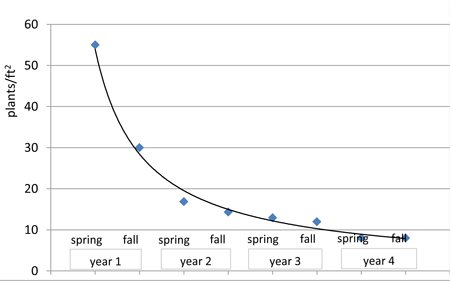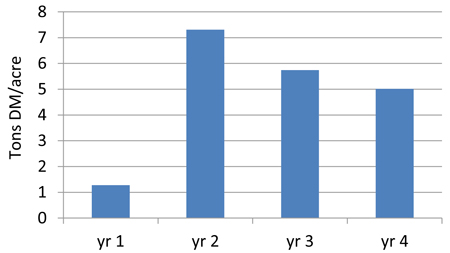Fall assessment of alfalfa stands
Producers should evaluate alfalfa plant density in the fall to determine whether it is time to rotate to the next crop.
This is a good time for producers to determine whether to rotate out of alfalfa. Alfalfa is an amazing perennial crop that produces high yields of good quality forage in multiple cuttings per year, but over time stands become less productive. One of the reasons for lower production in older fields is stand loss. Seeding year plant populations of pure stands of alfalfa are typically greater than 50 plants/ft2, but by the end of the second year, the population will drop below 15 plants/ft2 (Figure 1).
Figure 1. Alfalfa plant density (plants/ft2) in the seeding year (year 1) and three
production years (years 2-4) at East Lansing, Mich. (Source: MSU Research Trials, 2008)

Until recently, alfalfa plant loss was believed to be caused by winterkill, but current studies have shown that more plants die in the summer than winter. Competition between alfalfa plants is the primary cause for this reduction, but disease, cutting frequency and environmental conditions play a role as well. Despite extreme plant loss in the second year, yields are usually greater than any other time (Figure 2). This is due, in part, to compensatory growth of more stems that occupy the open space between plants. An alfalfa plant can only occupy so much space, eventually gaps between plants appear; yields decrease and weeds invade.
Figure 2. Alfalfa forage yield (tons dry matter/acre) from the seeding year (yr 1)
and three production years (yr 2-4) at East Lansing, Mich. (Source: MSU Alfalfa Variety Trials, 2008)

So, what is the minimum number of alfalfa plants to trigger a rotation? Researchers in northern environments under non-irrigated conditions concluded that four plants/ft2 was the minimum number for viable hay production of pure alfalfa. The easiest time to determine stand population is about one week after harvest. At this time, alfalfa crowns are clearly visible and regrowth should have begun. Producers should randomly select multiple locations (five or more) within the field to conduct counts to estimate population.
Remember that alfalfa produces an autotoxic compound (possibly medicarpin), so using a no-till drill to plant alfalfa into alfalfa stand is not recommended. Missouri trials have demonstrated that newly planted alfalfa seedlings within a 15-inch radius of an established alfalfa plant are either killed or stunted due to presence of the autotoxin. Soil type and soil moisture conditions will affect the persistence and the degree of autotoxic effects. Alternatively, annual (Italian) or perennial ryegrass can be successfully established using a no-till drill if there is a desire to maintain the stand for one additional year.



 Print
Print Email
Email


